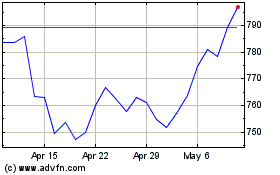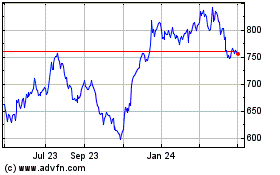BlackRock Assets Drop Sharply -- WSJ
January 17 2019 - 3:02AM
Dow Jones News
By Dawn Lim
This article is being republished as part of our daily
reproduction of WSJ.com articles that also appeared in the U.S.
print edition of The Wall Street Journal (January 17, 2019).
BlackRock Inc.'s assets fell below the $6 trillion mark in the
fourth quarter, a sign of how volatile markets are posing new
challenges for the largest U.S. money managers.
The roughly $468 billion drop during the final three months of
2018 was the largest such decline between quarters since September
2011. BlackRock ended 2018 with $5.98 trillion in assets under
management, according to its latest quarterly report.
The decrease wasn't attributable to net redemptions but to an
end of-year market rout that eroded the value of the firm's
existing assets.
The reversal reinforces the pressures facing BlackRock and the
rest of the asset-management industry as firms search for new ways
to grow. Clients aren't committing as much new money to
asset-management products, and fund managers are competing to push
prices lower. Choppy markets add another layer of uncertainty.
BlackRock became the world's largest money manager over the last
decade thanks to rising markets and a shift to cheaper products
that mimic market indexes, crossing the $6 trillion mark in late
2017. The firm has amassed a sprawling line of businesses that
could help insulate it in a tougher market environment.
But a significant amount of BlackRock's revenue comes from fees
tied to the assets it manages and a sizable chunk is in stock
markets. This leaves it exposed to shifts in investor
sentiment.
A market rout in the fourth quarter helped push BlackRock's
revenues down by about 9%, to $3.43 billion. Revenue from
investment-advisory, administration fees and securities lending
fell by 4% in fourth quarter compared with year-ago period.
Performance fees, or the money the firm gets for beating
markets, fell sharply to $100 million from $285 million in the year
ago period. This was largely due to lackluster performance among
its hedge funds.
Earnings for the asset manager fell 60% to $927 million, or
$5.78 a share, from a year earlier.
A bright spot was revenue from technology services, including
from BlackRock's Aladdin risk and portfolio management tools, which
rose 27% for the quarter.
BlackRock is taking steps to simplify the firm and reallocate
resources to higher-growth areas such as illiquid alternatives and
retirement investments. Last week it announced roughly 500 job
cuts, which affects 3% of its workforce, and elevated a lieutenant
to Chief Executive Laurence Fink into a new role focused on the
company's strategy and international growth. A key priority going
forward is China.
"BlackRock always has been willing to aggressively embrace
change," Mr. Fink told analysts in an earnings call.
There were signs in the fourth quarter that BlackRock is having
some success moving money into more lucrative business lines.
Analysts pointed to a key ratio of how much BlackRock earns in base
fees on each dollar it manages.
That percentage is "declining at a slower pace than we expect,"
said Michael Cyprys, an equity analyst who covers brokers and asset
managers for Morgan Stanley.
One problem that BlackRock wasn't able to escape, however, was a
slowdown in new net money committed by clients. That amount fell to
$49.77 billion in the latest quarter, down from $102.93 billion in
net inflows in the comparable period.
It isn't the only giant wrestling with investor pullbacks.
Vanguard Group, the world's second largest money manager, said its
net inflows for the fourth quarter of 2018 fell to roughly $55.4
billion as compared with about $77.4 billion a year earlier. Its
assets under management fell to $4.9 trillion at the end of 2018,
down from $5.3 trillion in September.
Not all units of BlackRock are experiencing a slowdown in new
flows, however. Its fast growing iShares exchange-traded funds
business collected a record $81.4 billion in net inflows for the
quarter, benefiting as investors jumped into those products to
protect themselves from market turmoil or bet on year-end market
swings.
"A product like that has promise to grow over the long term, but
I wouldn't expect to be seeing $80-plus billion dollars of inflows
every quarter going forward," said Kyle Sanders, an analyst at
Edward Jones who covers financial services.
Kimberly Chin contributed to this article.
Write to Dawn Lim at dawn.lim@wsj.com
(END) Dow Jones Newswires
January 17, 2019 02:47 ET (07:47 GMT)
Copyright (c) 2019 Dow Jones & Company, Inc.
BlackRock (NYSE:BLK)
Historical Stock Chart
From Mar 2024 to Apr 2024

BlackRock (NYSE:BLK)
Historical Stock Chart
From Apr 2023 to Apr 2024
